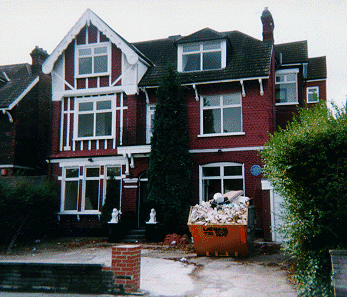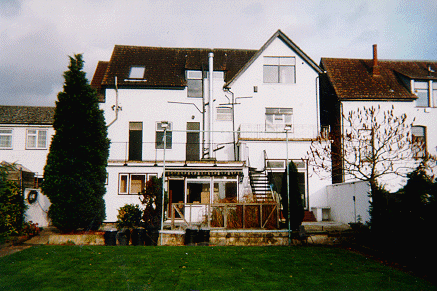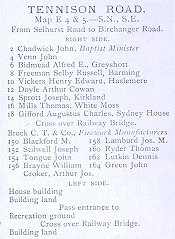




Back to index
Stories written in the house
Favourite links
Mail me: baritsuman@geocities.com
| The Adventure of the Norwood Building | ||||||||||||||||||||||||||||||||||
 |
||||||||||||||||||||||||||||||||||
| Front view | ||||||||||||||||||||||||||||||||||
| Front View: Sorry about the skip (dumpster), Norwood Builders! | ||||||||||||||||||||||||||||||||||
| Address: | ||||||||||||||||||||||||||||||||||
| 12 Tennison Road, | ||||||||||||||||||||||||||||||||||
| South Norwood, | ||||||||||||||||||||||||||||||||||
| London SE25 5RT | ||||||||||||||||||||||||||||||||||
 |
||||||||||||||||||||||||||||||||||
| Unfortunately, the rear has been modified quite considerably over the years, to comply with fire regulations. | ||||||||||||||||||||||||||||||||||
| You can glimpse what it must have been like from the view of No. 14 next door. | ||||||||||||||||||||||||||||||||||
| Sir Arthur Conan Doyle lived here with his family from 1891 to 1894. He wrote 21 Holmes stories in the house, which he bought when he gave up medical practice to pursue his writing career. | ||||||||||||||||||||||||||||||||||
| This page has been created for admirers of Sir Arthur Conan Doyle and his work to join me in encouraging the British government to ensure that his former home in South London, is preserved now, by law, in perpetuity. | ||||||||||||||||||||||||||||||||||
| I must emphasise that the building is not currently under any threat, but it remains in an area where land values are high, and may potentially face a risk in the future. |
||||||||||||||||||||||||||||||||||
| It is not possible to visit the house, but the front is easily seen from the road. No.12 is a residential home, so please do not disturb the owners if you visit. |
||||||||||||||||||||||||||||||||||
| Nearest Rail Station: South Norwood, direct line from Waterloo, central London. |
||||||||||||||||||||||||||||||||||
| Description: | ||||||||||||||||||||||||||||||||||
| I am still researching the history of the house, however, local directories list the address from 1890, it laying unoccupied for at least a year prior to finding it’s illustrious purchaser in August 1891. The building was constructed uniform with it’s neighbour, no.14. and occupies a commanding position within Tennison Road. | ||||||||||||||||||||||||||||||||||
| This 1891 directory lists an erroneously titled Arthur Cowan Doyle at the house, and curiously, a nieghbour called 'Charles Augustus'! Just a coincidence? | ||||||||||||||||||||||||||||||||||
 |
||||||||||||||||||||||||||||||||||
| Front Elevation: | ||||||||||||||||||||||||||||||||||
| Overlooking the houses opposite, and South Norwood recreation ground, the building has three floors and a small basement/cellar. It is of traditional brick construction, with decorative hung tiles to first floor elevation and timber stud-work to first floor and second floor gable front, with brick nogging between the timbers. | ||||||||||||||||||||||||||||||||||
| Decorative timber soffits survive, though lost on the replaced dormer window to the third floor. Rubbed brick arches are over the entrance doorway and one ground floor window. | ||||||||||||||||||||||||||||||||||
| Roof tiles are inappropriate replacement clay items. | ||||||||||||||||||||||||||||||||||
| Though the original windows and entrance door have been lost, but a quick comparison with the photograph of no.14, next door, shows it would not be difficult or costly to reinstate it’s general appearance to an earlier form, though the interior is much altered and would be rather more of a challenge. | ||||||||||||||||||||||||||||||||||
| BIG PHOTO OF INTERIOR-HALL & DOWN STAIRS | ||||||||||||||||||||||||||||||||||
| Rear: | ||||||||||||||||||||||||||||||||||
| Extended and greatly altered to comply with fire regulations when it was converted into a residential home for people with learning difficulties.. | ||||||||||||||||||||||||||||||||||
| The garden is approximately 70 metres long, and as the view displays, is most unusual in the area, also illustrating the quiet blandness of the surrounding streets! | ||||||||||||||||||||||||||||||||||
| History | ||||||||||||||||||||||||||||||||||
| This 1891 map shows the house as it was when ACD arrived, with trams running across the end of the road, and open fields very close by. | ||||||||||||||||||||||||||||||||||
 |
||||||||||||||||||||||||||||||||||
| South Norwood in 1891 was a very quiet, semi-rural area, between the encroaching suburbs of London, and the town of Croydon. No.12 faced open fields front and back, and open countryside just a tricycle ride away in every direction. | ||||||||||||||||||||||||||||||||||
| In just 15 years the situation was to change dramatically. The Ordnance Survey map of 1896 shows development springing up on nearby land, and in that period of time, the tramway in Selkirk Road was installed and field after field was very quickly filled with dull terraced (row) housing. By 1913 the entire area was suburban development, | ||||||||||||||||||||||||||||||||||
| As a result Tennison Road is quite unique in the area in having large houses with land. This makes them lend a character and variety to the environs which it cannot afford to lose. | ||||||||||||||||||||||||||||||||||
| Sadly, this very uniqueness the house possesses has meant it has suffered | ||||||||||||||||||||||||||||||||||
| a conversion to a residential home and this has left it much altered within. | ||||||||||||||||||||||||||||||||||
| Nevertheless still of merit, bringing an aspect of grandeur to the area, no.12, because of it’s size and elevation, dominates street from every angle. | ||||||||||||||||||||||||||||||||||
| The ACD Connection | ||||||||||||||||||||||||||||||||||
| ‘throughout August 1891 I haunted house-agents’ finding eventually, ‘a suitable house, modest but comfortable’ : Arthur Conan Doyle, autobiography, ‘Memories and Adventures’, 1929, commenting on his new house, 12 Tennison Road. | ||||||||||||||||||||||||||||||||||
| At the age of 32, Arthur Conan Doyle moved to Tennison Road when he decided to give up medical practice and concentrate on his blossoming writing career, since the growing success of Holmes, first published in 1887, historical novels and his other works, had already demonstrated his earning potential. In 1891, he was on the crest of a wave, the first collected stories, ‘The Adventures of Sherlock Holmes’ being published in the July, brought an income he later frankly admitted was near £1600 p.a.. | ||||||||||||||||||||||||||||||||||
| Though the nearly illegible 1891 census records the address as vacant in July, much is known of his life in Norwood. He arrived in August/September, and resided there with his wife, Mrs Louise Conan Doyle, daughter Mary Louise (born 1892), and invited younger sisters Connie and Lottie to live there, with their House-Keeper Mrs Hawkins. It seems likely there would have been another servant at least. | ||||||||||||||||||||||||||||||||||
| The influence of his time there was significant, he regularly rode into the countryside with Louise on their tricycle, and his domestic happiness was recorded in a novel, ‘Beyond the City’, a tale of suburban romance, which matches his time at Tennison Road well, even to the Tennis he played with his sisters on the lawn. | ||||||||||||||||||||||||||||||||||
| But it is for Holmes that Conan Doyle is one of the most well known authors in the world, and here he was to write twenty-one of the sixty adventures of the world’s most famous consulting detective. This element of his life is well documented, however, it may be pertinent to recall one story in particular, ‘The Norwood Builder’ written after he left, but still interesting; | ||||||||||||||||||||||||||||||||||
| Jonas Oldacre, a Norwood builder, is found murdered in his study. The house is described as ‘A big modern villa of staring brick’, the murder scene being Oldacre’s study, which just as ACD’s study at Norwood, overlooked the road, was ‘to the left of the front door’, and had ‘French windows looking on to the garden’ - the similarity is striking. | ||||||||||||||||||||||||||||||||||
| The building received many visitors - the connection with the ‘literati’ of the late Victorian era is compelling- Conan Doyle wrote an Operetta with J.M. Barrie (Author of Peter Pan) there , his friend Jerome K Jerome visited, one of his sisters was to marry E.W. Hornung who wrote the ‘Raffles’ stories and his association with Bram Stoker (Author of Dracula), agent of the actor Henry Irving began at Norwood. | ||||||||||||||||||||||||||||||||||
| Also, at this time, Conan Doyle became interested in the paranormal, joining the Institute for Psychic Research in 1891, showing the beginning of an interest that was to transform his life. | ||||||||||||||||||||||||||||||||||
| In 1894, Louise was diagnosed with TB, so the family left for Switzerland for her to convalesce, leaving Mrs Hawkins in charge.. | ||||||||||||||||||||||||||||||||||
| They were never to return to Norwood, eventually building a house in the Surrey hills, away from the pollution of London. | ||||||||||||||||||||||||||||||||||
| A House in the Global Village!! | ||||||||||||||||||||||||||||||||||
 |
||||||||||||||||||||||||||||||||||
| A view from a while ago. Conan Doyle's study was on the left of the door. | ||||||||||||||||||||||||||||||||||
| The Blue Plaque commemorates his time there. | ||||||||||||||||||||||||||||||||||
| Sherlock Holmes is arguably the most readily identifiable icon of Britain, and globally famous - a walk around the Baker Street web-ring on this site can easily confirm that! | ||||||||||||||||||||||||||||||||||
| Holmes is a symbol perhaps more instantly recognisable than any other literary creation, and remains in print 111 years after his creation. Is it a leap of the imagination to imagine the stories will still be appreciated in the years to come? | ||||||||||||||||||||||||||||||||||
| Though London boasts a Holmes Museum , Pub and Memorabilia Shop, there is no more tangible link with the past, or with an author, than his home. The house still has an atmosphere, a resonance, which is not in the least eroded. | ||||||||||||||||||||||||||||||||||
| Conan Doyle’s other homes have either been demolished (Southsea), are in National Parks (New Forest), are listed (Hindhead, Crowborough) or are in conservation areas (Wimpole St., Edinburgh), yet here we have perhaps the most significant link to his work - unprotected. | ||||||||||||||||||||||||||||||||||
| There can be no economic argument for the loss of this building, it’s size, history, location and uniqueness will always find it a purchaser as an hotel, home or private dwelling. Yet a threat remains, if simply because it has a plot approximately 25 metres by 100, to entice the ‘Moriartys’ of development. | ||||||||||||||||||||||||||||||||||
| The criteria for ‘listing’ (UK statutory protection) is governed by ‘Public Planning Guidance Notes 15’, where section 6 describes criteria for individual listing: Buildings of either ‘architectural or historical interest, or those with close historical associations with nationally important people or events’ are considered, but are usually approached when the building has ‘some quality or interest in the physical fabric of the building itself to justify the statutory protection afforded by listing’, or it must have remained in a form ‘which directly illustrates and confirms it’s historical associations’. | ||||||||||||||||||||||||||||||||||
| Each case must be considered upon it’s own merit, and I believe the house is a worthy building, valuable in the context of Norwood and it’s environs, yet the social and historical context of no.12 makes it’s situation quite unique. | ||||||||||||||||||||||||||||||||||
| One imagines that 68 years after Ann Hathaway’s passing, it would have seemed inconceivable her cottage could be the sacrosanct place it has become. Clearly, if we are to be true custodians of the future, then imagination, understanding, and a long term view is surely called for. | ||||||||||||||||||||||||||||||||||
| The importance of the building has been recognised by London’s Blue Plaque Committee, now overseen by English Heritage, when they erected a plate to commemorate Conan Doyle’s former ownership, and by the Urban Policy Department of Croydon District Council, who have placed the house upon their own list of buildings they wish to protect. That is not however any statutory protection, and leaves the threat of myriad counter-pressures to disregard it. | ||||||||||||||||||||||||||||||||||
| My personal view is that the current position for No.12 is a result of a certain degree of intellectual elitism toward popular fiction, yet, I am sure the time has come for the value of Conan Doyle’s home to be fully realised. | ||||||||||||||||||||||||||||||||||
| The Listing Branch of the UK Department of National Heritage can ‘spot list’ a building, giving it immediate protection from demolition, alteration or change without consultation with the Department. This would mean the house would be safe forever! | ||||||||||||||||||||||||||||||||||
| Wherever you are in the world, you can help! The more requests they receive, the harder our voice will be to ignore! | ||||||||||||||||||||||||||||||||||
| Please follow the link below, and print the map, photos and brief notes provided. This is unfortunately a requirement of their procedures. | ||||||||||||||||||||||||||||||||||
| Please also add your own comments and send the whole to the address listed requesting ‘spot listing’. | ||||||||||||||||||||||||||||||||||
| Thank you! | ||||||||||||||||||||||||||||||||||
| Preserve the house! Back to index Stories written in the house Favourite links Mail me: baritsuman@geocities.com |
||||||||||||||||||||||||||||||||||